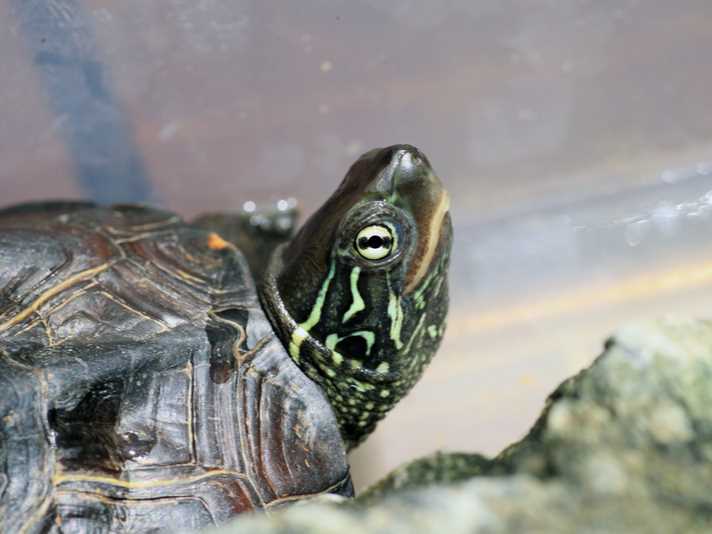One of the most distinctive features of the Reeves Turtle is its beautiful shell. The shell is typically dark brown with bright yellow markings, resembling an oriental design. This eye-catching pattern is why they are sometimes called the “Chinese Turtle”.
All About Reeves Turtles
Physical Characteristics
- The Reeves turtle has a unique olive or black colored shell with yellow or orange markings.
- It has a streamlined body and webbed feet, which makes it an excellent swimmer.
- The turtle can grow up to 10 inches in length and weighs around 4 pounds.
Habitat
Reeves turtles are typically found in ponds, marshes, and slow-moving streams in China. They prefer habitats with clean, freshwater and dense vegetation.
Behavior
- They are mainly diurnal, active during the day, and spend most of their time basking in the sun.
- They are relatively social animals, but they can also be territorial and may exhibit aggressive behavior towards other turtles.
Diet
The diet of Reeves turtles primarily consists of aquatic plants, insects, snails, worms, and small fish.
Conservation Status
Due to habitat loss and illegal pet trade, Reeves turtles are considered an endangered species. It is illegal to trade or keep them as pets without proper permits.
Fun Facts About Reeves Turtles
- Appearance: Reeves turtles have a brown or black shell with yellow markings, giving them a unique and beautiful pattern. Their shells can grow up to 7 inches in length, and their bodies are usually olive or brown in color. They have webbed feet that make them excellent swimmers.
- Habitat: Reeves turtles are primarily aquatic and are often found in ponds, streams, and other bodies of water in East Asia. They prefer habitats with dense vegetation and clean water. In captivity, they require a well-maintained habitat that mimics their natural environment, including a large water area and plenty of hiding spots.
Care Tips

One of the most important aspects of caring for Reeves Turtles is providing them with suitable enclosure. Their habitat should mimic their natural environment as much as possible. This includes providing a large enough tank or pond with clean and filtered water. The water temperature should be maintained at around 75-80 degrees Fahrenheit (24-27 degrees Celsius).
The enclosure should also include both land and water areas, as Reeves Turtles are semi-aquatic and need dry land to bask and rest. The land area should be large enough for the turtle to comfortably move around and have adequate hiding spots. Adding rocks, logs, and plants can create a more stimulating environment for the turtles.
Another important aspect of care is monitoring the turtle’s shell health. The shell should be checked regularly for any signs of damage or disease. Keeping the water clean and providing a suitable basking area will help prevent shell problems. If any issues are observed, consulting a veterinarian specializing in reptiles is recommended.
By following these care tips, you can provide a suitable and enriching environment for the endangered Reeves Turtles, ensuring their health and happiness in captivity.
Habitat Information

The Reeves turtle has a distinctive shell that is brownish with dark markings. It can grow up to 20 centimeters in length and has a lifespan of around 30 years. These turtles are omnivorous and feed on a variety of plants, insects, and small aquatic animals. They are primarily active during the day and spend the majority of their time in the water, basking on rocks or logs to regulate their body temperature.
Life Expectancy
The life expectancy of Reeves turtles can vary depending on several factors, including their living conditions and how well they are cared for. On average, these turtles can live for 20 to 30 years in captivity, but with proper care, some individuals have been known to reach up to 40 years or more.
To ensure a long and healthy life for your Reeves turtle, it’s crucial to provide them with the proper care. This includes maintaining a clean and spacious aquarium or pond with ample swimming space. Additionally, the water temperature should be kept between 75 to 80 degrees Fahrenheit, and a basking area should also be available for the turtle to soak up heat and UVB rays.
In terms of diet, Reeves turtles are omnivorous, meaning they eat both plant and animal matter. Their diet consists of a variety of fruits, vegetables, insects, and aquatic plants. It’s essential to provide a balanced diet to ensure that all nutritional needs are met.
All About Reeves Turtles: Diet and Conservation
Diet
Reeves Turtles have a unique feeding behavior called “benthic feeding,” where they search for food at the bottom of the water body. They use their strong jaws and sharp beak to grab and crush their prey. They are also known for their excellent sense of smell, which helps them locate food in the water.
Conservation
Illegal trade is another major threat to the Reeves Turtle population. They are often captured and sold as pets or for use in traditional medicine. This illegal trade puts additional pressure on their already dwindling numbers.
Conservation efforts are underway to protect and restore the habitats of the Reeves Turtle. These efforts include establishing protected areas, improving water quality, and raising awareness about the importance of conservation. Additionally, laws and regulations are being enforced to curb the illegal trade of these turtles.
It is crucial for individuals to refrain from purchasing or keeping Reeves Turtles as pets, as this further contributes to their decline in the wild. Instead, supporting conservation organizations and spreading awareness about the species can help in their preservation.
All About Reeves Turtles Breeding
Turtle Breeding Process
Firstly, it is crucial to provide a suitable habitat for the turtles. This can be accomplished by setting up a spacious tank or pond that mimics their natural environment. The water should be clean and well-maintained, with a temperature around 25-28 degrees Celsius. Additionally, a basking area with a heat lamp should be provided for the turtles to regulate their body temperature.
Caring for Turtle Hatchlings
Once the hatchlings emerge from their eggs, they should be carefully transferred to a separate tank. The tank should be set up with appropriate water and basking areas, as well as hiding spots for the hatchlings to feel secure.
The diet of the hatchlings should consist of small insects, worms, and aquatic plants. It is essential to provide a varied and balanced diet to ensure their proper growth and development.

I’m Lena Adams—a product of an unconventional upbringing in the African wilderness. My father, a daring explorer of African wildlife, sparked my fascination with reptiles, a passion that intertwined with the tragic loss of my mother during an expedition, leaving an indelible mark on my life. Driven to understand the creatures that captivated my parents, I embarked on my journey, sharing insights about reptiles, frogs, and lizards on my website. Through my explorations and conservation efforts, I honour my family’s legacy while seeking connections—to the creatures, nature, and the mother whose presence I yearn to understand.
